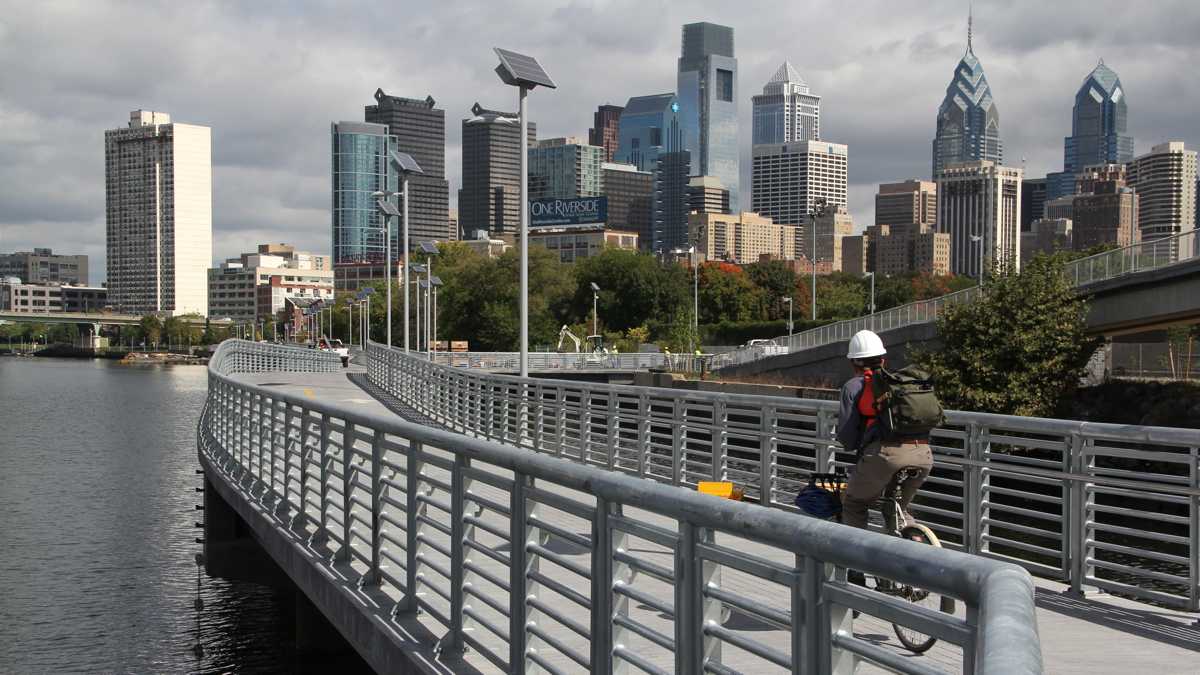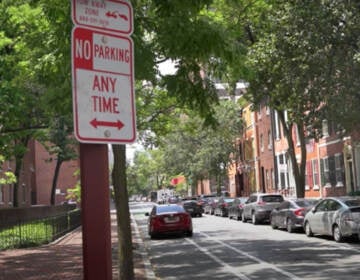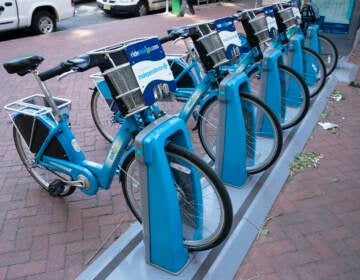My evolution as an urban bicyclist
I realized when I got home in one piece that I had survived. In spite of the fear, the ride felt great. I wanted to try it again.

Schuylkill River Boardwalk. (Emma Lee/WHYY)
Speak Easy is examining issues of street use in Philadelphia. What should our priorities be to ensure safe streets for pedestrians, bicyclists, motorists and transit users? Seeking diverse perspectives on these issues, NewsWorks is hosting a public forum, “Philadelphia Streets Under Pressure,” on June 30 at WHYY studios. Registration is free at whyy.org/speakeasy.
—
I was desperate. I needed to get to a doctor’s appointment at 9th and Walnut in Center City Philadelphia from my home at 21st and Cherry. In a hurry as usual, I had not given myself enough time to take the bus. Using my car, given traffic and parking, wasn’t an option. So, I decided to pull my bike out of the basement and pump up the tires. I rode down to Market Street and then around City Hall to Juniper and Chestnut.
The number of cars and buses was overwhelming, the sound of engines deafening, and my heart leapt in fear when motorists passed me within inches. I realized, though, when I got home in one piece, that I had survived. However scary the ride was, it was super convenient and fast. I made it to the doctor on time and was home in a jiffy. In spite of the fear, the ride felt great.
I wanted to try it again.
Picking up good and bad habits
That was in the late ’90s. Gradually, as I used my bike repeatedly on the same trips (to my children’s school or to my office), I grew more accustomed to riding with traffic. I used bike lanes when I could and took the full lane when there weren’t any. I learned to communicate with drivers with my eyes and arms and try not to surprise them with sudden movements. With time, I grew more confident and comfortable. The fear receded, and riding with traffic felt normal.
But I also developed some bad habits that I picked up from watching others. I rode against traffic when the one-way streets weren’t convenient. I rode on sidewalks when I wanted to get around a long queue of cars. Occasionally, I ran a red light thinking that I wasn’t doing any harm as long as the cross-traffic had passed.
But by 2008, 10 years after my first on-road ride, bicycling had started to explode in Philadelphia because of $4 gallons of gas and a transit strike. The behavior of bicyclists became front-page news in 2009 with the Inquirer editorializing them as “two-wheeled hazards.” This was in the midst of Philly’s first full-blown “bike lash,” and City Council was eyeing measures such as bike registration requirements and increased fines as a response.
Part of the solution or part of the problem?
These developments made it clear that I needed to change how I rode. My bad habits were work-arounds and, to be honest, lazy. My own behavior was contributing to a bad perception about bicyclists, and I needed to set a good example to help change the dynamic on the street. I knew that, even though I was only one among more than 10,000 who were biking around Philadelphia, every bicyclist’s behavior was being scrutinized and was contributing to the street’s temperament and environment. And for every bicyclist who was a jerk, there needed to be one who wasn’t.
So, I went cold turkey and entered into the three-step program.
- I stopped at every red light.
- I kept off the sidewalk.
- I rode with traffic, no matter if it was not a direct route to my destination.
I was pleasantly surprised that I didn’t lose much time, and the payoff was worth it. I felt better that I wasn’t contributing to ill-will among the motorists or pedestrians who I encountered on my ride. Pretty soon, obeying traffic rules felt like buckling my seatbelt when driving.
Today, I can’t imagine not following them.
Infrastructure encourages good behavior
Since 2009, the streets’ bicycle infrastructure (the paint and markings that create lanes) improved. The Spruce and Pine buffered bike lanes, the South Street Bridge, Schuylkill Banks, Fairmount Avenue bike lanes and the Boardwalk have all contributed to making bicycling on the street and on the Schuylkill River Trail better.
The Bicycle Coalition‘s manual counts documented that streets with better bicycling infrastructure had less sidewalk riding, less wrong-way riding and more helmet usage. People on bikes use streets with higher-quality facilities more than those without. The number of people who are using the streets to get around by bike is growing. And they are a diverse bunch — people of all ages in their work clothes, wearing helmets, carrying groceries or their children, and by and large obeying traffic rules.
That’s not to say that Philadelphia doesn’t still have problems. There are bicyclists who don’t follow traffic rules — just like there are drivers and pedestrians who don’t follow traffic rules. There are still many gaps in the bicycle network, and many streets are in poor condition. I know that many people won’t start bicycling on the streets until bike lanes are physically protected and feel even safer.
Advocating for more funding and political support to help the city install higher-quality bike lanes and promote better education and enforcement programs are all priorities for the Bicycle Coalition.
Ultimately, a connected and protected network of on-road bike lanes and off road trails throughout Philadelphia and its surrounding counties is what is going to make it possible for an even larger segment of the region’s population to safely use a bike to get around every day. Because everyone should be able to ride their bike to a doctor’s appointment without fearing for their life.
—
Sarah Clark Stuart is deputy director of the Greater Philadelphia Bicycle Coalition. Sarah’s advocacy began in 2004 with the campaign to preserve public access to the Schuylkill River Trail in Center City, now known as Schuylkill Banks. Since joining the Bicycle Coalition in 2006, she has been a key player in its accomplishments.
WHYY is your source for fact-based, in-depth journalism and information. As a nonprofit organization, we rely on financial support from readers like you. Please give today.





